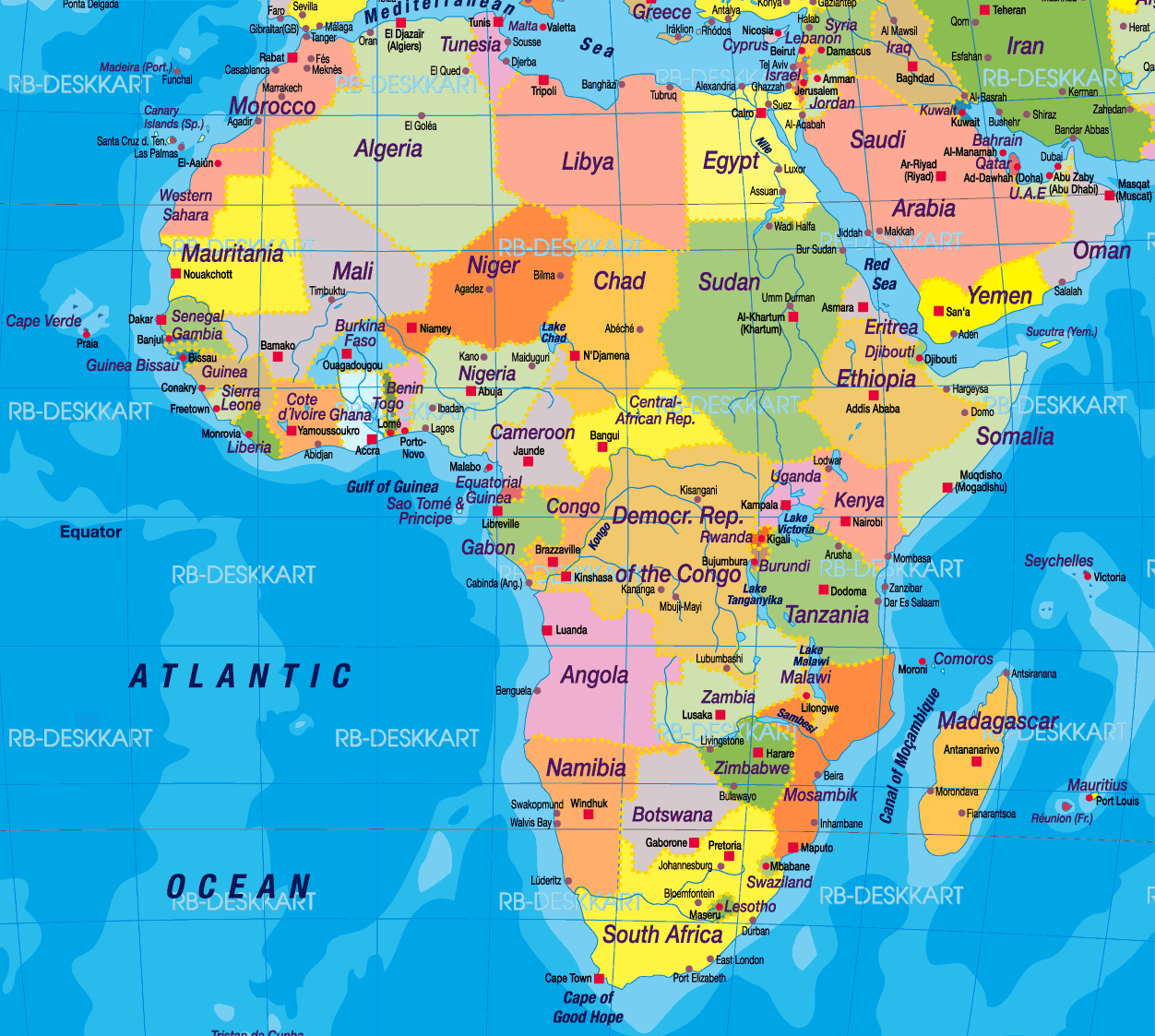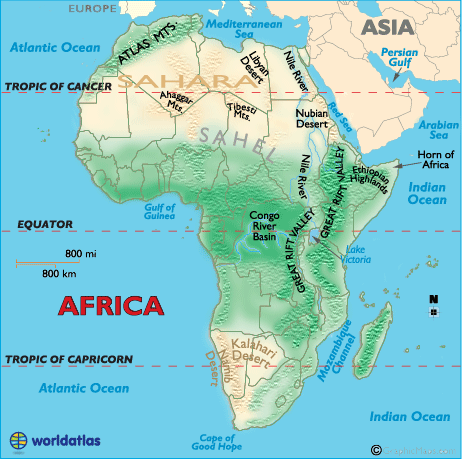Africa is the world's second-largest and second most-populous continent, after Asia. It covers an area of 30.2 million square kilometers or about 20 percent of Earth’s land surface with the Equator passed though the middle of the continent.
Boundary
The continent is surrounded by water, with the Mediterranean Sea to the north, the Atlantic Ocean to the west and south, and the Indian Ocean and Red Sea to the east. The estimated population for 2009 is about a billion people.
Countries
1. Northern Africa consist of 6 African countries. They are Morocco, Tunisia, Libya, Algeria, Egypt, and Western Sahara.
2. Western Africa includes Benin, Burkina, Cape Verde, Gambia, Ghana, Guinea, Guinea-Bissau, Ivory Coast, Liberia, Mali, Mauritania, Niger, Nigeria, Senegal, Sierra Leone, and Togo.
3. Central Africa comprises of Cameroon, Central African Republic, Chad, Congo, Democratic Republic of Congo, Equatorial Guinea, and Gabon
4. Eastern Africa contains Burundi, Djibouti, Eritrea, Ethiopia, Kenya, Rwanda, Somalia, Sudan, Tanzania, and Uganda.
5. Southern Africa encompasses Angola, Botswana, Lesotho, Malawi, Mozambique, Namibia, South Africa, Swaziland, Zambia, and Zimbabwe.
Physical Characteristic
Africa's landscape is varied. The land is higher in the east and south and lower in the west. It is the oldest continent. Therefore its mountains are not as high as those on other continents. This is because they have been worn down over millions of years by erosion. The highest point in Africa is Mount Kilimanjaro in Tanzania, at 5,895 meters above sea level.
Atlas Mountains
This mountain system runs from south-western Morocco along the Mediterranean coastline to the eastern edge of Tunisia.
Sahara Desert
Sahara desert covers almost one-third of the continent. It is the largest desert in the world at approximately 9,065,000 square kilometres in size. The desert almost completely has no rain. Small amount of water comes from the Atlas Mountains in the north and from the Nile in the east.
Sahel
The Sahel is a wide land on the southern part of the Sahara Desert. It is the transition zone between the dry areas of the north and the tropical areas of the south. It receives very little rain. Most of the vegetation is sparse grasses and shrubs.
Congo River Basin
The Congo River Basin of central Africa covers the area of the Democratic Republic of the Congo and much of Congo. The fertile basin is 3,600,000 square kilometres in size. It contains almost 20% of the world's rain forest. The Congo River is the second longest river in Africa.
Great Rift Valley
Great Rift Valley is a dramatic depression on the earth's surface, approximately 6,400 kilometres long. It extends from the Red Sea area near Jordan in the Middle East to Mozambique in the south. It is caused by huge volcanic eruptions hundreds of years ago. Nile River System
The Nile is the longest river in the world flowing 6,693 kilometres long. It originates in Burundi and flows north to drain in the Mediterranean Sea.
Great Rift Valley is a dramatic depression on the earth's surface, approximately 6,400 kilometres long. It extends from the Red Sea area near Jordan in the Middle East to Mozambique in the south. It is caused by huge volcanic eruptions hundreds of years ago. Nile River System
The Nile is the longest river in the world flowing 6,693 kilometres long. It originates in Burundi and flows north to drain in the Mediterranean Sea.
Kilimanjaro
Kilimanjaro is Africa’s tallest mountain in Africa, rising in east central Africa. It is a dormant volcano at 5,895 meters high.
Kalahari Desert
Kalahari Desert is about 259,000 square kilometers in size and covers much of Botswana, the south-western region of South Africa and all of western Namibia. Along the coastal areas of that country it's commonly known as the Namib Desert.
Climate
The climate of Africa is influenced by how far is it from the equator. Regions around the equator are the hottest in the world. Closer to the poles, the colder it gets.
The climate of Africa is influenced by how far is it from the equator. Regions around the equator are the hottest in the world. Closer to the poles, the colder it gets.
The humid equatorial zone is in the middle of the continent where the equator passing through. It has hot and humid climate.
Desert climate or arid is found in the northern half and the desert area in the southwest. Rainfall is extremely scarce and temperatures are very extreme. Although the daytime temperatures in the desert are high, nights can be extremely cold.
Subarctic climate can be found on top of high mountains such as Kirimanjaro Mountain in Tanzania.
Vegetation
The northern half of the continent is covered primarily with desert or arid vegetation. The central and southern areas contain both savanna plains and rainforest regions. In between, there is a convergence where vegetation patterns such as sahel, and steppe dominate.
Fauna
Africa has various kinds of wild animals both canivores such as lions, hyenas, and cheetahs , and herbivores such as buffaloes, deer, elephants, camels, and giraffes. Africa is also home to a variety of "jungle" animals including snakes and primates and aquatic life such as crocodiles and amphibians.


